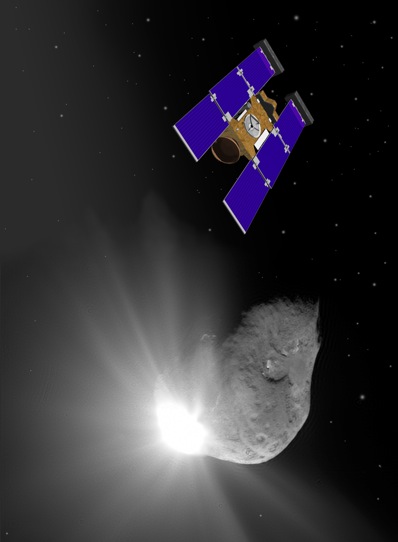



|

|

Stardust primed for second comet fly-by
by Louis Jagger
for ASTRONOMY NOW
Posted: 2 March 2010


Stardust, the first unmanned spacecraft to return comet samples to Earth, has been successfully aligned for its second and possibly final mission: to deal with NASA’s unfinished business. The American Astronomical Society announced the manoeuvre last month, which will enable Stardust to capture the aftermath of Deep Impact, the craft which in July 2005 struck comet Tempel 1 with an external probe.
The collision was ideal, with a small explosion comparable to about five tons of dynamite nonetheless causing a massive upheaval in the comet’s exterior and throwing great amounts of dust and ice into space. This cloud was thoroughly analysed and found to contain unexpected materials such as sodium and ethane, indicating the comet’s distant origins. However, the crater was not adequately photographed, which is where Stardust comes in.
 Comet Tempel 1 as seen by the Deep Impact spacecraft during the planned impact in 2005, shown here with the Stardust spacecraft. Comet Tempel 1 as seen by the Deep Impact spacecraft during the planned impact in 2005, shown here with the Stardust spacecraft.
This is a mission of many firsts. It is the first time a spacecraft has been reassigned after returning samples to Earth. It is the first time a comet has been revisited by a NASA spacecraft. And now, with arrival time revised by eight hours in a flawless ‘burn’ manoeuvre, it should be the first time we gain access to a detailed look inside a comet.
The much-travelled Stardust, logging over three billion miles and 4,000 days since its initial launch in 1999, will reach Tempel 1 on Valentine’s Day 2011. The revision of its meeting has been calculated according to when Deep Impact’s crater will most likely face towards the Sun and thus allow Stardust’s navigation camera to obtain as much detail as is possible during their brief encounter.
Stardust previously visited Wild 2, passing the comet in January 2004, taking photographs of the nucleus’ exterior and collecting dust samples from the comet’s trail. It then returned its findings to Earth in a sealed capsule in January 2006, in a delicate procedure to prevent the capsule smashing into dry land and destroying valuable information. In July 2007, the Tempel 1 interception was approved, and Stardust’s task rechristened Stardust-NExT (New Exploration of Tempel 1). Its path was altered to intercept the stricken comet, whose own orbit takes it around the Sun roughly once every five and a half years.
Of special interest will be how Tempel 1’s close pass of the Sun since Deep Impact has affected its surface, and indeed the area recently exposed by the impact. Theories abound as to how such processes affect a comet’s composition, and Joe Veverka, principal investigator, explained how he hoped “Stardust-NExT should give teeth to some of these theories, and take a bite out of others”.
Also of great importance will be the findings of the Dust Flux Monitor, an instrument which records particle interference as an electronic signal and thus records inconsistencies in the dust levels emanating from the comet, and a dust spectrometer, which will measure the mass and thus ionic valence of such particles. All instruments are working perfectly after over 4,000 days in space; as project manager Tim Larson said of the recent realignment manoeuvre, which changed Stardust’s speed by a mere 54 miles per hour, “We could not have asked for a better result from a burn with even a brand-new spacecraft”.
So, while Stardust and Tempel 1 both have a new partner next Valentine’s Day, spare a thought for the astronomers beneath, whose day, one suspects, will be more about data than dates.
|

|

|

|
|



